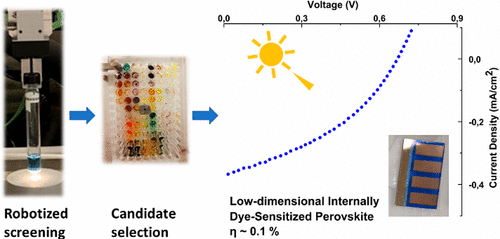当前位置:
X-MOL 学术
›
J. Am. Chem. Soc.
›
论文详情
Our official English website, www.x-mol.net, welcomes your
feedback! (Note: you will need to create a separate account there.)
Implicit Tandem Organic–Inorganic Hybrid Perovskite Solar Cells Based on Internal Dye Sensitization: Robotized Screening, Synthesis, Device Implementation, and Theoretical Insights
Journal of the American Chemical Society ( IF 14.4 ) Pub Date : 2020-10-15 , DOI: 10.1021/jacs.0c06698 Allan Starkholm 1, 2 , Lars Kloo 2 , Per H Svensson 1, 2
Journal of the American Chemical Society ( IF 14.4 ) Pub Date : 2020-10-15 , DOI: 10.1021/jacs.0c06698 Allan Starkholm 1, 2 , Lars Kloo 2 , Per H Svensson 1, 2
Affiliation

|
Low-dimensional hybrid perovskite materials offer significantly improved stability as well as an extensive compositional space to explore. However, they suffer from poor photovoltaic performance as compared to the 3D perovskite materials because of poor charge-transport properties. Herein, we present the concept of internal dye-sensitized hybrid perovskite compounds involving five novel low-dimensional perovskite-type materials 1–5 incorporating triarylmethane, phenazinium and near-infrared (NIR) cyanine cationic dyes, respectively. The synthesis characterization and theoretical analysis of these compounds are presented. Theoretical calculations provide interesting insights into the effects of these dyes on the band structure of the low-dimensional anionic metal-halides and especially highlight compound 1 as a promising photovoltaic candidate. Solar cell investigation of devices based on 1 were conducted. The results show an average power conversion efficiency (PCE) of about 0.1%, which is among the highest reported for a 1D material despite the use of undoped Spiro-OMeTAD as the hole-transport material (HTM). Incident photon-to-electron efficiency (IPCE) spectra confirm the contribution of the dye to the overall photocurrent of the solar cell. Moreover, examination of solar cell devices based on the bismuth-based compound 5 resulted in PCEs in the range of 0.1%. This illustrates the potential of this concept to be exploited for lead-free photovoltaics. Finally automated robotized screening of low-dimensional hybrid perovskite materials through the screening robot PROTEUS has emerged as a powerful tool in the search for novel perovskite-like materials. Our work highlights that the use of cationic dyes could induce interesting sensitizing properties to low-dimensional metal-halide chains and may therefore provide inspiration and new design strategies for the synthesis of new lead-free photovoltaic materials
中文翻译:

基于内部染料敏化的隐式串联有机-无机混合钙钛矿太阳能电池:机器人筛选、合成、设备实施和理论见解
低维杂化钙钛矿材料提供了显着提高的稳定性以及广泛的成分空间可供探索。然而,由于电荷传输性能差,与 3D 钙钛矿材料相比,它们的光伏性能较差。在此,我们提出了内部染料敏化杂化钙钛矿化合物的概念,涉及五种新型低维钙钛矿型材料 1-5,分别包含三芳基甲烷、吩嗪鎓和近红外 (NIR) 菁阳离子染料。介绍了这些化合物的合成表征和理论分析。理论计算为这些染料对低维阴离子金属卤化物能带结构的影响提供了有趣的见解,特别强调了化合物 1 作为一种有前途的光伏候选物。进行了基于1的设备的太阳能电池研究。结果显示平均功率转换效率 (PCE) 约为 0.1%,尽管使用未掺杂的 Spiro-OMeTAD 作为空穴传输材料 (HTM),但该效率是 1D 材料中报道的最高值之一。入射光子对电子效率 (IPCE) 光谱证实了染料对太阳能电池总光电流的贡献。此外,对基于铋基化合物 5 的太阳能电池器件的检查导致 PCE 在 0.1% 的范围内。这说明了这一概念在无铅光伏方面的潜力。最后,通过筛选机器人 PROTEUS 对低维杂化钙钛矿材料进行自动机器人筛选已成为寻找新型钙钛矿类材料的有力工具。
更新日期:2020-10-15
中文翻译:

基于内部染料敏化的隐式串联有机-无机混合钙钛矿太阳能电池:机器人筛选、合成、设备实施和理论见解
低维杂化钙钛矿材料提供了显着提高的稳定性以及广泛的成分空间可供探索。然而,由于电荷传输性能差,与 3D 钙钛矿材料相比,它们的光伏性能较差。在此,我们提出了内部染料敏化杂化钙钛矿化合物的概念,涉及五种新型低维钙钛矿型材料 1-5,分别包含三芳基甲烷、吩嗪鎓和近红外 (NIR) 菁阳离子染料。介绍了这些化合物的合成表征和理论分析。理论计算为这些染料对低维阴离子金属卤化物能带结构的影响提供了有趣的见解,特别强调了化合物 1 作为一种有前途的光伏候选物。进行了基于1的设备的太阳能电池研究。结果显示平均功率转换效率 (PCE) 约为 0.1%,尽管使用未掺杂的 Spiro-OMeTAD 作为空穴传输材料 (HTM),但该效率是 1D 材料中报道的最高值之一。入射光子对电子效率 (IPCE) 光谱证实了染料对太阳能电池总光电流的贡献。此外,对基于铋基化合物 5 的太阳能电池器件的检查导致 PCE 在 0.1% 的范围内。这说明了这一概念在无铅光伏方面的潜力。最后,通过筛选机器人 PROTEUS 对低维杂化钙钛矿材料进行自动机器人筛选已成为寻找新型钙钛矿类材料的有力工具。











































 京公网安备 11010802027423号
京公网安备 11010802027423号